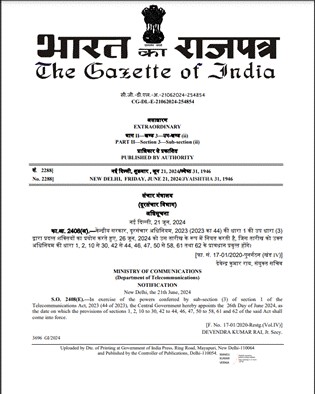On June 21, 2024, a significant milestone in India’s telecommunications landscape was marked with the Gazette Notification enforcing key sections of the Telecommunications Act, 2023. This pivotal legislation, passed by Parliament in December 2023 and subsequently receiving presidential assent, aims to revolutionize the sector by modernizing outdated colonial-era laws such as the Indian Telegraph Act, 1885, and the Indian Wireless Telegraph Act, 1933.
Historic Shift: Replacing Century-Old Colonial Laws
The Telecommunications Act, 2023 signifies a monumental departure from antiquated regulatory frameworks, aligning India’s telecommunications policies with contemporary technological advancements and global standards. This legislative overhaul is guided by four foundational pillars: Samavesh (Inclusion), Suraksha (Security), Vriddhi (Growth), and Tvarit (Responsiveness), collectively fostering the vision of a Viksit Bharat (Developed India).

Pillars of Progress: Samavesh, Suraksha, Vriddhi, and Tvarit
Samavesh (Inclusion)
Central to the Telecommunications Act, 2023 is the principle of Samavesh, ensuring equitable access to telecommunication services across urban, rural, and remote areas. The legislation expands the scope of the Universal Service Obligation Fund (USOF) to support underserved regions, bolstering connectivity and bridging the digital divide. Moreover, the Act introduces a Regulatory Sandbox to promote innovation and pilot projects, fostering a dynamic ecosystem for technological advancement.
Suraksha (Security)
In an era increasingly reliant on digital infrastructure, Suraksha emphasizes stringent measures to safeguard national security and public safety. The Act empowers authorities to establish telecommunication standards and conformity assessment protocols, crucial for maintaining robust cybersecurity frameworks and protecting critical infrastructure from potential threats.
Vriddhi (Growth)
Vriddhi underpins the Act’s provisions for accelerating telecommunication growth through streamlined processes and enhanced regulatory clarity. It introduces a comprehensive Right of Way (RoW) framework, facilitating efficient deployment of telecommunication infrastructure across public and private domains. By mandating non-discriminatory access to RoW and distinguishing telecom assets from underlying properties, the legislation aims to mitigate disputes and accelerate network expansion nationwide.
Tvarit (Responsiveness)
Tvarit underscores the Act’s commitment to operational agility and responsive governance. By mandating digital-by-design implementation, including online dispute resolution mechanisms, the legislation enhances administrative efficiency and transparency. Sections 61 and 62 ensure a seamless transition by maintaining continuity with existing regulations until comprehensive rules are established under the new legal framework.
Key Provisions Enforced
Definitions and Regulatory Clarity
The Telecommunications Act, 2023 provides unequivocal definitions of key terms essential for its implementation. This clarity not only reduces ambiguity but also enhances investor confidence, bolstering India’s appeal as a conducive environment for telecommunication ventures.
Right of Way Framework
A cornerstone of the Act, the RoW framework establishes guidelines for accessing public and private properties for telecommunication infrastructure deployment. Public entities, including government agencies and PPP projects, are mandated to facilitate RoW, ensuring equitable access while imposing reasonable fee ceilings. The Act’s provisions promote efficient use of shared resources and infrastructure, pivotal for scaling network capabilities nationwide.
Promoting National Security and Technological Sovereignty
Recognizing telecommunication as a critical sector for national security, the Act empowers regulatory bodies to set stringent standards and compliance measures. This proactive approach not only safeguards sensitive data but also nurtures indigenous technological advancements, positioning Indian developers at the forefront of global innovation in telecommunications.
Inclusive Service Delivery and User Protection
In line with the principle of Samavesh, the Act expands the USOF’s mandate to include support for universal services in underserved regions. It also introduces robust measures for protecting users against unsolicited communications, establishing a robust grievance redressal mechanism to uphold consumer rights in the digital realm.
Digital Transformation and Innovation
The Act’s emphasis on digital integration extends beyond governance to encompass innovation facilitation through Regulatory Sandbox initiatives. By fostering an environment conducive to experimentation and new technology deployment, the legislation stimulates sectoral growth and enhances India’s competitive edge in the global telecommunication market.
The Telecommunications Act, 2023 heralds a transformative era for India’s telecommunications sector, marking a decisive shift towards modernization, inclusivity, and security. By repealing obsolete laws and embracing progressive reforms, the legislation paves the way for enhanced connectivity, technological innovation, and economic growth. As India navigates the complexities of a digital age, the Act stands as a testament to proactive governance and strategic foresight, ensuring that the nation remains at the forefront of global telecommunications advancements.







